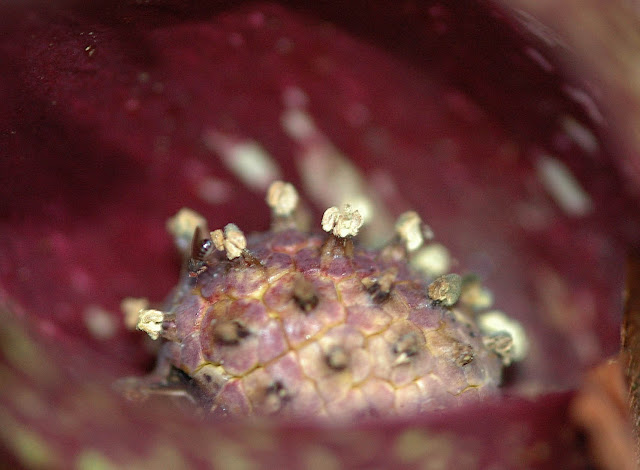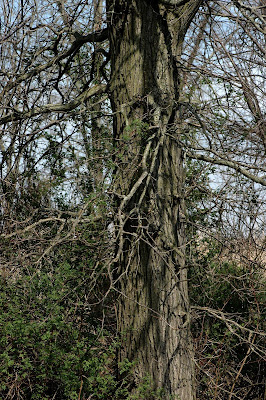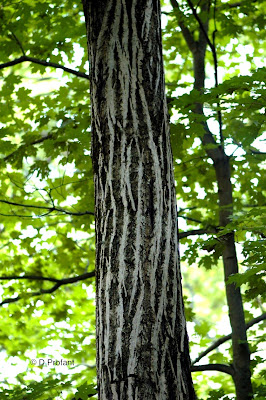It is interesting to go out in the field here in southern Ohio and watch things come and go. It's another to drive to northern Ohio and watch it happen all over again.
Skunk Cabbage,
Symplocarpus foetidus, has pretty much finished flowering in southern Ohio, but not so in the northern part of the state. I spent the week in Mahoning County looking for early spring bloomers. While the leaves are starting to pop up, the flowers are still hanging on.
Skunk Cabbage is known to produce heat inside the flower, even when outside temperatures are freezing. Carrion is known to generate heat as it decomposes, so besides the nasty smell and appearance of the plant, the heat may also serve as an attractant to pollinators.
The inside of Skunk Cabbage even has the look of rotting flesh. The green-maroon hood is known as a
spathe, not true leaves, but modified leaves that surround the flower.
The hood protects the round, golfball like flower structure inside. Bustling among the yellow pollen is a small gnat. Flies are some of the most common insects drawn to Skunk Cabbage.
Growing in a large area with the Skunk Cabbage was this plant I had never seen in flower. I had come across the leaves before, but didn't recognize the bloom. This is Butterbur
Petasites hybridus, a member of the Aster family.
Before getting too excited, I had forgotten this was a non-native. Butterbur has large round basal leaves similar to Coltsfoot, of which it is a distant relative.
Butterbur gets its name from older times when people churned their own butter and would wrap it and store it in the leaves of this plant.
Figuring where there's one exotic, there is probably more. Sure enough, the Myrtle or Periwinkle
Vinca minor was everywhere. Myrtle is a common ornamental used as a ground cover plant. The flowers are showy, but it does have a tendency to escape and spread if unchecked.
Growing mixed with the Myrtle was this attractive plant. It's
Scilla sibirica, the Siberian Squill. A very early bloomer, it was introduced into the country as a showy garden plant. Like Myrtle, it has the potential of being invasive.
Another sure sign of spring, all the woody plants are busting their buds open. This is Staghorn Sumac,
Rhus typhina, and yes it's native.
It may be spring, but there are plenty of signs remaining from the previous season. This is Basswood fruit,
Tilia americana. The nutlets dangle from a leafy like bract that acts as a hang glider to help spread the seeds.
Besides the woodlands, I got out into some nice wetlands. These areas were dominated by Silky Dogwood, Pin Oak, and the scraggly looking Swamp White Oak,
Quercus bicolor.
Swamp White Oak twigs are light brown and the buds are small and blunt. This species often shows hair-like stipules sticking out between the buds.
This mysterious picture is not a hairy caterpillar. It is a willow in flower. The following is just a collection of various species of Willow I found in bloom. Willows have either male or female sexed trees. The first couple of pictures are female flowers followed by the males.
Waterfowl migration is beginning to peak also at this time. With limited telephoto ability, I was 'somewhat' able to sneak up on these mated pairs of Ring-neck Ducks.
And what am I suppose to make of this? Why a flock of Shovelers of course. You can always click on the photos to be sure.
Just because I could hide in the brush along a dike, didn't mean I could get very close. Here's a series of shots of Blue-wing Teal taking flight.
What did you expect, eyeball shots?
I was getting ready to leave when I noticed something way off in the distance grab my attention. Could this be an Osprey nest, seemed too big. Wait a minute, eagle?
Sure enough, as I got closer, it turned out to be a pair of Bald Eagles nesting. It's only my third visit to this site, but I had no idea this nest was even here. Now I've seen my share of eagles and nests before, but never with a camera in hand. Good news, Bald eagle sightings continue to increase in Ohio. In the last couple years at least 200 nests have been recorded with over 150 of them being active.
I also know better than to walk out in the open in front of a nesting pair. I was lucky to have a large series of dikes in this wetland to hide behind. These aren't fantastic closeups like other people may capture. My old 400mm telephoto doesn't work with my current camera, but I shot with the largest files possible, then cropped repeatedly. So it looks closer than I actually was. Neither bird ever flew or moved, but I still got out of the area as quick as possible.
Also, this area is not open to the general public. I acquired a permit that allows me access to the grounds, so I will not disclose the location. Regardless, it was a nice way to end the week.




















































